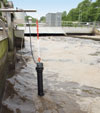

Current legislative demands have led to an increase in the complexity of modern wastewater treatment plants adhering to effluent limits at the outlet. Furthermore, energy cost trends show that energy efficiency is growing in importance in wastewater treatment and industry in general. The challenge and future key to success for operators will be the ability to manage plant reliability, reduce complexity and optimise energy efficiency.
Linked to actual energy benchmark discussions for wastewater treatment plants, this article demonstrates, in the case of aeration control, how control strategies based on on-line data support increased plant safety by optimising energy input. Furthermore, the aim of energy monitoring systems and an implementation strategy is to provide energy savings in a strategic and sustainable manner.
Aim of nutrient online measurement for controlling aeration
The aeration step in a biological wastewater treatment plant (WWTP) is the key process step as well as the main cost factor in terms of energy demand. Approximately 60% of the energy demand of a municipal WWTP is attributable to aeration to eliminate COD and nutrients. Independent of the process layout, there are several parameters with the potential to contribute significantly towards process optimisation.
When considering the main microbiological elimination reactions in aeration and non-aeration periods, three parameters are typically tracked: oxygen, ammonia and nitrate.
The importance of oxygen
Oxygen is a very important parameter for successful wastewater treatment via biological processes. Because the degradation of organic matter as well as the conversion of ammonia to nitrate (nitrification) is done by aerobic bacteria, a sufficient aeration of the basin is a must. Microbiological activity of the nitrification bacteria is strongly influenced by the oxygen concentration.
For WWTPs to meet the legislated outlet limits, plant operators have to guarantee a sufficient oxygen concentration in the aeration basin. On the other hand, over-aeration offers no benefits, but causes a significant increase in the specific energy demand of the plant.
Online measurement of oxygen is used to limit over as well as under-aeration. Several examples demonstrate the positive effect of online oxygen measurement in the aeration basins or basin zones. The prevention of under-aeration by a minimum set-point makes the whole treatment process more reliable and improves the outlet situation independent of the inlet load. Furthermore, inefficient energy usage due to over-aeration is avoided.
ISE sensors for ammonia and nitrate improve process reliability and energy efficiency
The positive effect of using oxygen to avoid under and over-aeration is well demonstrated. But today, modern solutions additionally use nutrient parameters like ammonia and nitrate for real-time aeration control. The main benefit is dynamic control of the aeration rate in relation to the detected change of load situations and again, optimised energy efficiency. This means that only online information regarding load and nitrification/de-nitrification situations from the process allow for the consequent exploitation of existing energy savings potential in the plant.
The basis is a new measuring principle for ammonia and nitrate. Wet-chemical analyser systems are not the best choice in these applications because the implementation into control strategies requires fast reaction times from the measuring system. The so called ion-selective measuring method (ISE) was developed specifically for these applications and offers accurate, reliable and fast measurements in aeration basins.
The sensor is available as a one-parameter sensor (ammonia or nitrate) or as a two-parameter sensor for both parameters in parallel. The two-parameter version fits perfectly for the intermittent process or for SBR (sequence batch reactors), because both processes have aeration and non-aeration phases in one basin.
Process reliability: what does that mean for a WWTP?
After considering the various aspects surrounding energy efficiency, we also look at overall plant reliability. For a wastewater plant operator, plant reliability should mean the following:
1. Meet legislation demand continuously and independent of the inlet situation.
2. A safe work environment for all employees.
Adhering to legislation for the outlet is a factor of the efficiency of the biological treatment step, ie, in the aeration basins. Water temperature, load situation and potentially disturbing substances can all influence the specific activity of bacteria.
The idea is to use the online ammonia concentration for an adjustment of the oxygen concentration. In the case of a high load situation, the bacteria can be supported by higher oxygen concentrations. In those situations, the energy efficiency is weak, but the outlet limits are guaranteed – even in the case of fluctuating loads at the inlet. In the case of an under-load situation, the control strategy with ammonia adjusts the oxygen set-point to a very low level. These are the process situations where energy savings are realised without negatively affecting the limits.
For more information contact Hennie Pretorius, Endress+Hauser, +27 (0)11 262 8000, [email protected], www.za.endress.com
| Tel: | +27 11 262 8000 |
| Email: | [email protected] |
| www: | www.endress.com |
| Articles: | More information and articles about Endress+Hauser South Africa |

© Technews Publishing (Pty) Ltd | All Rights Reserved